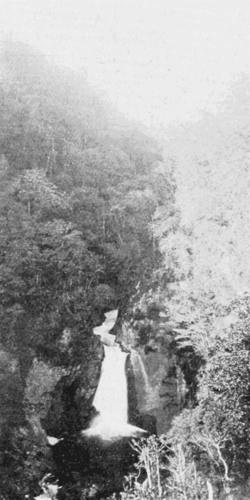a thousand feet; and indeed an elevation of seven hundred and seventy-six feet has been enough to withdraw the waters from the last canal across the continental barrier. But of this again.
The same story of the rise of the land and the separation of the seas is repeated in Central America—in Honduras, in Nicaragua, and in Colombia, whether at Panama  Fig. 6.—Falls below Atoyac, passing through a short, deep cañon, descending from the terrace plain faintly shown in the high background of the picture. or not, as appears from the observations of Mr. J. Crawford, Dr. W. M. Gabb, Dr. G. A. Maack, and especially of Mr. F. C. Nicholas, in the Atrato Valley. But the phenomena accompanying the great changes of level have not been so fully studied farther south as in Mexico.
Fig. 6.—Falls below Atoyac, passing through a short, deep cañon, descending from the terrace plain faintly shown in the high background of the picture. or not, as appears from the observations of Mr. J. Crawford, Dr. W. M. Gabb, Dr. G. A. Maack, and especially of Mr. F. C. Nicholas, in the Atrato Valley. But the phenomena accompanying the great changes of level have not been so fully studied farther south as in Mexico.
The Manner in which the Elevation of the Plateau occurred.—There are various great terrestrial movements known to geologists. Extensive continental areas are gently rising and others are sinking. These oscillations, so far as time is concerned, appear slow—as, for instance, the sinking of the New Jersey coast at the supposed rate of a foot in half a century, or of the New Orleans district, of a foot in twenty years; while the rising of the northern part of the continent, as between the Adirondack Mountains of New York and the St. Lawrence River, is at the rate of a foot in twenty or twenty-five years. Within a generation the changes of level in the physical geography of a special district are no more apparent to the ordinary inhabitant than the shallowing or deepening of small channels which interfere with or favor the passage of canoes or small boats, or the gentle backing of waters which make swampy grounds or the reverse. Even with their effects, accumulated for centuries, the changes do not often affect the course of the drainage or obstruct it. By this gentle continental movement the mountains are not formed, nor are ridges squeezed up into existence, although they often give rise to high land. Since the beginning of the Glacial
